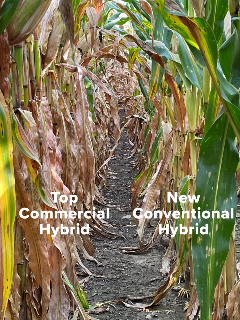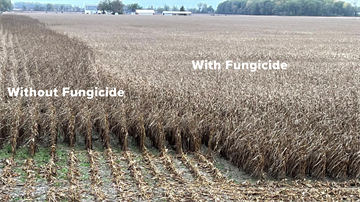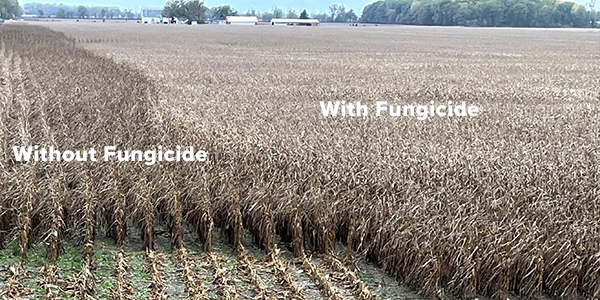AGRONOMICSUPPORT
YOU CAN TAKETO THE FIELD
Two Ways to Prevent Yield Loss from Tar Spot
You can’t control tar spot, but you can put up a good fight against the yield-robbing leaf disease. Use these tried and true tips from our agronomists to make a plan to combat tar spot next year.
Step 1: Understand the Disease
 Tar spot was first identified in the United States in northern Illinois in 2015. Since then, it has turned into a major corn leaf disease that can cause huge economic loss – knocking off between 20 and 60 bushels depending on the severity of the outbreak. The fungus is identified by small, raised black spots scattered across the upper and lower leaf surfaces. Think about taking a paint brush full of black paint and splattering it onto the leaves of your corn – that’s what tar spot looks like.
Tar spot was first identified in the United States in northern Illinois in 2015. Since then, it has turned into a major corn leaf disease that can cause huge economic loss – knocking off between 20 and 60 bushels depending on the severity of the outbreak. The fungus is identified by small, raised black spots scattered across the upper and lower leaf surfaces. Think about taking a paint brush full of black paint and splattering it onto the leaves of your corn – that’s what tar spot looks like.
The pathogen that causes tar spot can overwinter in corn residue, so tar spot pressure last year means there’s already an increased chance to see the disease this season. Spores can travel in the wind, so even if you didn’t have tar spot on your farm last year, you could see it in 2022. Wet weather is where tar spot thrives, and WeatherTrends360 is predicting above average precipitation in August and September. Take a look at the weather forecast in your area to understand if wet conditions will increase tar spot pressure.
Step 2: Manage Pressure
Managing tar spot begins before the planter even hits the dirt. Selecting a corn hybrid with strong tolerance to tar spot is the first step to set your farm up for success. There are still no tar spot-resistant hybrids, but LG Seeds agronomist Phil Brunner, CCA says LG59C72 “laughs at tar spot”.
 In-season tar spot management starts with scouting. Walk your fields and for tar spot about 10 days before pollination and continue through R3, or corn milk stage. Look at the bottom of the plant first – the disease starts at the bottom of the leaves and works its way up the plant. While there’s no official economic threshold established yet, agronomist Justin Schneider, CCA has developed a fungicide plan that delivers results: If you see tar spot lesions on the ear leaf or above, on 30% or more of the plants, a fungicide is warranted. Use a fungicide at tasseling (VT), and don’t be afraid to spray all the way through milk stage (R3).
In-season tar spot management starts with scouting. Walk your fields and for tar spot about 10 days before pollination and continue through R3, or corn milk stage. Look at the bottom of the plant first – the disease starts at the bottom of the leaves and works its way up the plant. While there’s no official economic threshold established yet, agronomist Justin Schneider, CCA has developed a fungicide plan that delivers results: If you see tar spot lesions on the ear leaf or above, on 30% or more of the plants, a fungicide is warranted. Use a fungicide at tasseling (VT), and don’t be afraid to spray all the way through milk stage (R3).
Tar spot pressure is heavy in the Midwest, but every year it expands into new crop-growing acres. Be on the lookout for the disease and follow up with your local LG Seeds agronomist for tried and true tar spot management tips that work in your area.
Sources
Crop Protection Network
Tar Spot of Corn - Crop Protection Network
Hoosier Ag Today





